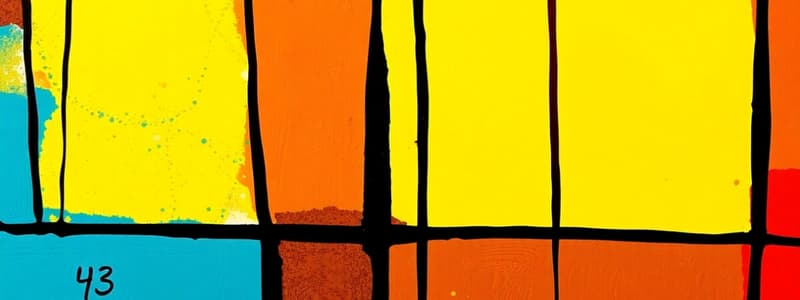Podcast
Questions and Answers
What color change occurs in the Biuret protein assay to indicate the presence of proteins?
What color change occurs in the Biuret protein assay to indicate the presence of proteins?
- Blue to purple (correct)
- Yellow to orange
- Brown to blue
- Blue to green
The peak absorbance wavelength for the Biuret method is 595 nm.
The peak absorbance wavelength for the Biuret method is 595 nm.
False (B)
What compound interacts with peptide bonds in proteins during the Biorad method?
What compound interacts with peptide bonds in proteins during the Biorad method?
Coomassie Brilliant Blue G
The peak absorbance wavelength for the Biorad method is at ______ nm.
The peak absorbance wavelength for the Biorad method is at ______ nm.
List one advantage and one disadvantage of the Biuret method.
List one advantage and one disadvantage of the Biuret method.
What is the first step in the Bradford protein assay procedure?
What is the first step in the Bradford protein assay procedure?
Match the following protein assay methods with their characteristics:
Match the following protein assay methods with their characteristics:
What does the Biuret method indicate when the color changes from blue to purple?
What does the Biuret method indicate when the color changes from blue to purple?
What is the peak absorbance wavelength for the Biuret method?
What is the peak absorbance wavelength for the Biuret method?
Which of the following is a disadvantage of the Biuret method?
Which of the following is a disadvantage of the Biuret method?
The Biorad method is less subject to interference with other compounds.
The Biorad method is less subject to interference with other compounds.
What is the peak absorbance wavelength for the Biorad method?
What is the peak absorbance wavelength for the Biorad method?
To calculate the concentration of the unknown BSA sample, one must generate a __________.
To calculate the concentration of the unknown BSA sample, one must generate a __________.
Match the following protein assay methods with their characteristics:
Match the following protein assay methods with their characteristics:
Flashcards are hidden until you start studying
Study Notes
Principles of Protein Assays
-
Biuret Method: Measures protein concentration based on cupric ions (Cu²⁺) binding to peptide bonds under alkaline conditions.
-
Color changes from blue to purple, signifying protein presence; peak absorbance at 540 nm.
-
Advantages: Simple method, minimal interference from other compounds.
-
Disadvantages: Less sensitivity in measuring total protein concentration compared to other methods.
-
Biorad Method (Bradford Assay): Detects proteins through the interaction of Coomassie Brilliant Blue G dye with peptide bonds in phosphoric acid.
-
Color shifts from brown to blue indicating protein presence; peak absorbance at 595 nm.
-
Advantages: Sensitive, accurate measurement of total protein concentration, less prone to interference from other substances.
-
Disadvantages: Variation in dye-protein binding capacity can affect results.
Lab Procedure Overview
-
Biuret Protein Assay:
- Set spectrophotometer to 540 nm.
- Generate standard curve for Biuret protein assay.
- Read absorbance from 500x, 100x, and 10x dilutions of sample A.
- Calculate concentrations for unknown diluted samples.
-
Bradford Protein Assay:
- Set spectrophotometer to 595 nm.
- Generate standard curve for Bradford protein assay.
- Read absorbance of unknown BSA sample.
- Calculate concentration for the unknown BSA sample.
Lab Report Requirements
- Introduction: Brief overview of measuring protein concentrations.
- Materials: List of chemicals and instruments used with their concentrations.
- Methods: Concise steps explaining the experimental procedure.
- Results:
- Include raw data tables.
- Present standard curve graphs with properly labeled axes and concentration units for both assays.
- Provide equations and calculations for sample concentrations in Biuret and Bradford assays.
- Discussion/Conclusion: Analyze results, address unexpected findings, suggest improvements, and discuss the significance of the lab work.
- Submission Format: Use the filename format - BIOL3120_Section_Lastname_Firstname_.
Principles of Protein Assays
-
Biuret Method: Measures protein presence via the interaction of cupric ions (Cu²⁺) with peptide bonds in alkaline conditions, causing a color change from blue to purple.
-
Absorbance: Peak wavelength for detection is at 540 nm.
-
Pros: Simple methodology with low interference from other compounds.
-
Cons: Less sensitivity compared to the Biorad method; cannot measure total protein concentrations accurately.
-
Biorad Method: Uses Coomassie Brilliant Blue G dye, which interacts with peptide bonds in phosphoric acid, resulting in a color shift from brown to blue.
-
Absorbance: Peak wavelength for detection is at 595 nm.
-
Pros: Easy to perform, highly sensitive, and exhibits low interference from other substances.
-
Cons: Variability in dye-protein binding capacity can affect results.
Lab Procedures
-
Biuret Protein Assay:
- Set spectrophotometer to 540 nm.
- Create a standard curve.
- Measure absorbance for dilutions (500x, 100x, 10x) of sample A.
- Calculate protein concentration for diluted samples.
-
Bradford Protein Assay:
- Set spectrophotometer to 595 nm.
- Create a standard curve.
- Measure absorbance for unknown BSA sample.
- Calculate concentration of the unknown BSA sample.
Lab Report Requirements
- Introduction: Overview of protein concentration measurement methods.
- Materials: List of chemicals and instruments with concentrations used.
- Methods: Brief outline of experimental steps.
- Results:
- Raw data organized in tables.
- Standard curve graphs for Biuret and Bradford assays, including correctly labeled axes and concentration units.
- Equations and calculations for sample A concentrations (500x, 100x, 10x) in Biuret assay.
- Equations and calculations for unknown concentration in Bradford assay.
- Discussion/Conclusion: Analyze results, discuss unexpected findings, propose improvements, and highlight the significance of the lab.
- File Naming: Format for submission is BIOL3120_Section_Lastname_Firstname.
Testing Summary
- Biuret Method: Qualitative protein presence test.
- Biorad Method: Quantitative protein test, more sensitive and reliable for total protein measurement.
Studying That Suits You
Use AI to generate personalized quizzes and flashcards to suit your learning preferences.





